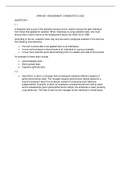Samenvatting
Samenvatting Biology Of Cancer
- Instelling
- Rijksuniversiteit Groningen (RuG)
In dit document staat alle informatie die je moet weten om een goed cijfer te halen op het tentamen van biology of cancer. Alle informatie uit de lectures staat erin, duidelijk omschreven en uitgelegd.
[Meer zien]













